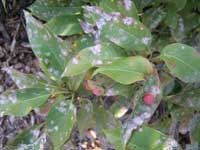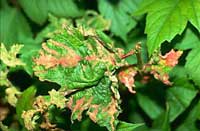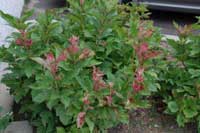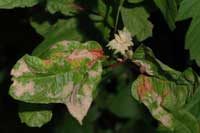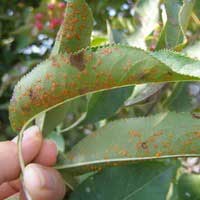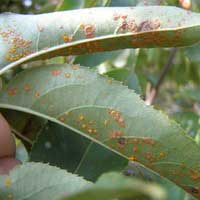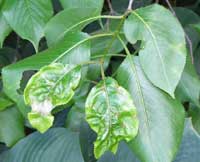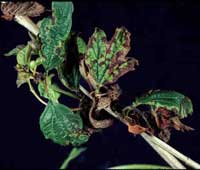Extension > Garden > Diagnose a problem > What's wrong with my plant? > Deciduous > Viburnum > Spots or blotches on leaves
Viburnum > Leaves > Spots or blotches on leaves
1 of 5
Powdery mildew
Microsphaera penicillata or Erysiphe viburni
- White, powdery fungal growth on both upper and lower surface of leaves
- Tiny round black fungal structures can sometimes be seen within white spots
- Leaves may turn reddish purple or pale yellow around fugal growth
- Leaves may be twisted or deformed by infection
- Common on lower shaded branches, or on shrubs grown in shady areas
- More information on Powdery mildew
2 of 5
Erineum gall
Eriophyid mites
- Red velvety patches on terminal leaves.
- Commonly found on leaves of cranberry viburnums
- Produced by microscopic eriophyid mites
- More information on Erineum gall
3 of 5
Rust
Coleosporium viburni
- Pale yellow to orange leaf spots
- Spots are raised bumps on the underside of the leaf and break open to release bright orange powdery spores
- Common on lower inner branches
- More information on rust
4 of 5
Downy mildew
Plasmorpha viburni
- Leaf spots are first yellow then brown
- Spots may be angular or have feathery edges depending on species of viburnum
- Fuzzy, grayish-white areas of fungal growth may be visible on underside of blotches
- Spots may join together to form large blotches.
- Young leaves may become crinkled or distorted
- In severe cases, infected leaves may fall
- More information on Downy mildew
5 of 5
Bacterial leaf spot (bacterial blight)
Pseudomonas syringae pv viburni
- Leaf spots are first yellow then brown
- Spots may be angular or have feathery edges depending on species of viburnum
- Fuzzy, grayish-white areas of fungal growth may be visible on underside of blotches
- Spots may join together to form large blotches.
- Young leaves may become crinkled or distorted
- In severe cases, infected leaves may fall
- More information on Bacterial leaf spot



